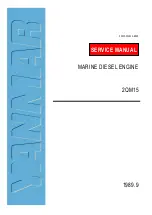
WP13 Diesel Engine Series Operating Manual
22
basic reasons are found out, never dismantle the diesel engine arbitrary. Otherwise, not
only the fault cannot be eliminated, but more serious problems may happen due to
improper assembly after dismantled.
2.
The high-pressure fuel pump, ECU, common rail pipe, supercharger and other key parts
should not only need dedicated instrument and equipment, but also need some
experienced repairmen, so inexperienced users shall never disassemble or adjust such key
parts at will if conditions are not satisfied.
6.2 Common Faults and Troubleshooting
6.2.1 The Diesel Engine Can Not Be Started
(1) The starter does not work
The WP13 series diesel engines have their starters controlled by ECU, in time of normal work, the
ECU will output a current to drive the starting relay, and after the relay is connected, the battery will
drive the starter to start the engine. When any fault occurs, the inspection should mainly focus on
the neutral gear.
Several elements necessary for inspections: neutral switch, starting relay, and relevance between the
battery and the parking switch
◆
Check whether the neutral position is engaged
Before starting, first check whether the gear shift lever is engaged in the neutral position
◆
Check the position of the parking switch (which should be in its “OFF” state)
The parking switch is designed as an inching type, able to reset automatically. Check whether this
switch is normal.
If this switch cannot reset automatically as designed, you should check whether this switch is in its
“ON” state.
◆
Check whether the neutral switch and wiring is intact, and try to use the emergency start (with
the ignition switch pressed continuously for more than 5 seconds)
For engine with its starter controlled by ECU, in time of starting, the ECU will first determine
whether the neutral position is engaged according to the signal from the neutral switch; when the
neutral switch is damaged or bad connected, the ECU cannot receive the neutral signal and the
starter will not work.
◆
Check whether the battery cannot drive the starter due to excessively low voltage
General speaking, the battery voltage is 24V and it cannot drive the starter if the voltage is too low.
You can use the voltage tester of a multimeter to check the voltage or use a fault diagnosis
instrument to read the actual value of the “battery voltage”.
◆
Check whether the starter relay and its wiring is intact
Check whether the wiring terminal surface is contaminated with too much oxide and whether the
wiring terminal surface bolts are loose or fractured.
◆
Check whether the starter has been burnt out
Use a multimeter to check whether the starter relay is
normal
◆
Check whether the ignition and starting switches
have gone bad
Turn the ignition key to the “ON” position and see whether the instrument panel indicators light up.
Ignition key switch











































